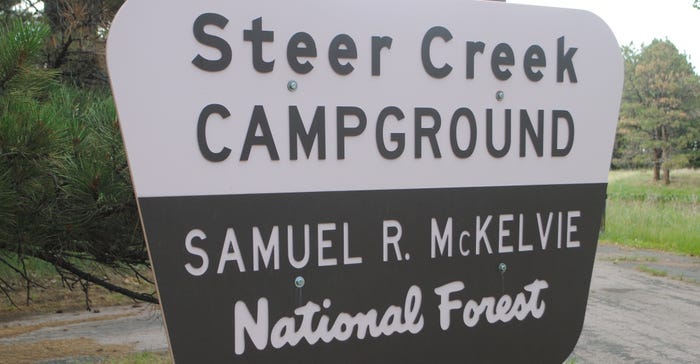
It has been called one of the most remote campgrounds in the Great Plains and, perhaps, in the country. The Steer Creek Campground on Steer Creek at the Samuel R. McKelvie National Forest — about 16 miles south of Nenzel, Neb., in Cherry County off State Spur 16F — is in the heart of Nebraska’s Sandhills.
It is a lonely, remote and beautiful Sandhills landscape, tucked away into the shade of almost century-old hand-planted ponderosa pine trees in the southeast corner of the forest. It is sought out by campers and outdoor enthusiasts because of those exact qualities.
Who was Samuel McKelvie?
But how did McKelvie get a forest named after him? And how does a forest spring up in the Sandhills? McKelvie, who died 66 years ago this January, was a former editor and publisher for Nebraska Farmer magazine for more than 50 years of his life, and he was Nebraska’s 19th governor.
Born in 1881 at Fairfield, Neb., McKelvie attended the University of Nebraska and graduated from the Lincoln Business College in 1901. He sold advertising for a publication known as the Twentieth Century Farmer in Omaha before being hired as editor of Nebraska Farmer in 1905.
By 1908, he was the principal owner and publisher of NF. He served as lieutenant governor from 1913-15 and threw his hat into the ring for governor in 1918. McKelvie beat incumbent Keith Neville and became known as the “boy governor” when he was inaugurated at age 37 the following January.
During his time as governor, running from 1919-23, McKelvie oversaw the initiation of the Nebraska state park system, and the approval of plans for a new state capitol building, which broke ground in 1922.
Back to Nebraska Farmer
After serving his term as governor, McKelvie stepped back into his role at NF. In addition to NF, where he continued a crucial interest for the rest of his life, and his public service role on the Federal Farm Board, he had a great interest in improving cattle in the state.
He and his wife, Martha, developed a large herd of purebred Herefords on their ranch, By the Way, in Cherry County, and McKelvie even served a term as president of the American Hereford Association. He died on Jan. 6, 1956, after two heart attacks at a winter home in Mesa, Ariz., and is buried at Wyuka Cemetery in Lincoln.
The 116,079 acres of mostly grassland, part of the U.S. Forest Service Nebraska National Forests and Grasslands from the ranger district offices in Halsey, was designated in McKelvie’s name by President Richard Nixon in 1971. It had originally been set aside as the Niobrara Forest Reserve by President Theodore Roosevelt in 1902.
The forested areas of the region were hand-planted more than 75 years ago to eastern juniper, Scots pine and ponderosa pine, with the entire forest running just north of the Snake River and northwest of Merritt Reservoir.
Beautiful and remote
Steer Creek Campground includes 23 units equipped with picnic tables, fire rings and eight stalls available in a corral for horseback riders. There is a hand water pump and a 1-mile nature trail called the Blue Jay Trail, which starts and ends at the campground.
Driving through the forest, hand-planted trees often line the State Spur that cuts through the heart of the unit, but the majority of the land is still native Sandhills grassland. It wouldn’t be surprising for visitors to see pronghorn antelope, white-tailed or mule deer, coyotes or foxes within the forest lands, as well as pheasants, grouses and turkeys.
Learn more at fs.usda.gov.
About the Author(s)
You May Also Like






